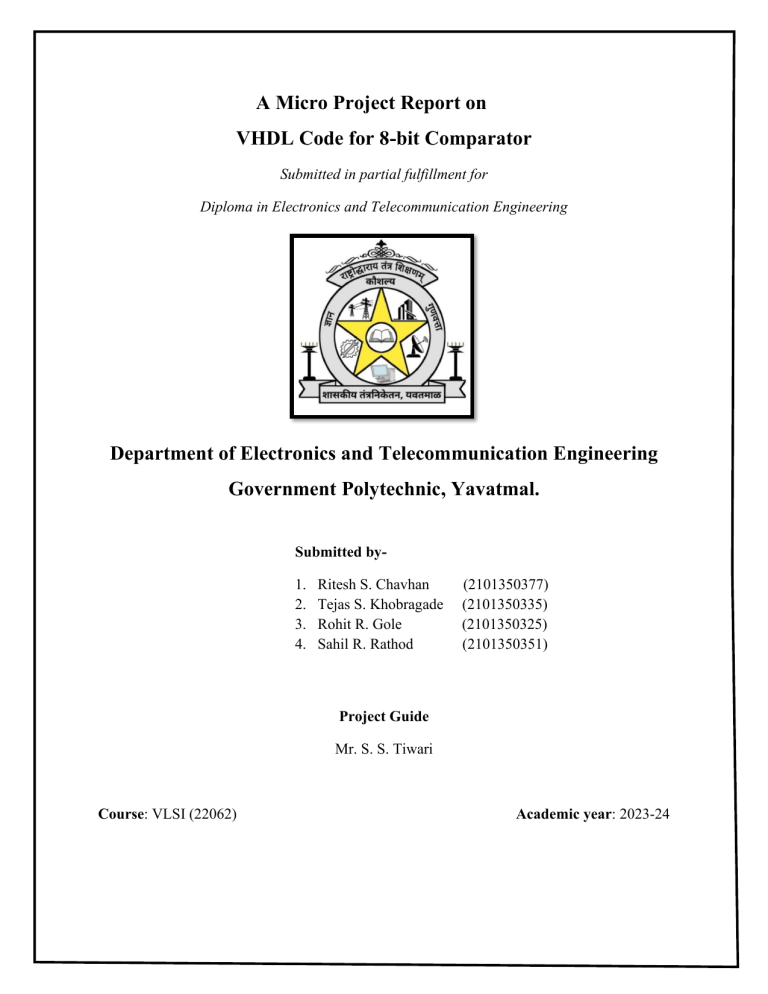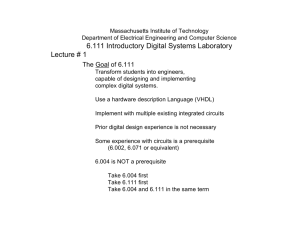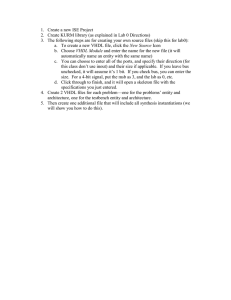
A Micro Project Report on VHDL Code for 8-bit Comparator Submitted in partial fulfillment for Diploma in Electronics and Telecommunication Engineering Department of Electronics and Telecommunication Engineering Government Polytechnic, Yavatmal. Submitted by1. 2. 3. 4. Ritesh S. Chavhan Tejas S. Khobragade Rohit R. Gole Sahil R. Rathod (2101350377) (2101350335) (2101350325) (2101350351) Project Guide Mr. S. S. Tiwari Course: VLSI (22062) Academic year: 2023-24 CERTIFICATE This is to certify that a micro project titled “VHDL Code for 8-bit Comparator” has been duly completed by the following students in satisfactory manner as part of the course VLSI (22062) in Electronics and Telecommunication Engineering department, Government Polytechnic, Yavatmal. Submitted by1. 2. 3. 4. Project Guide Mr. S. S. Tiwari Ritesh S. Chavhan Tejas S. Khobragade Rohit R. Gole Sahil R. Rathod HOD Mr. P. P. Pawar (2101350377) (2101350335) (2101350325) (2101350351) Principal Dr. R. P. Mogre ACKNOWLEGEMENT It is an incident of pleasure for submitting this Micro-Project we take this opportunity to express our deep sense of gratitude and great thanks to guide us Mr. S. S. Tiwari who has been a constant source of guidance and inspiration through the micro-project work. We shall ever be grateful to him for the encouragement and suggestion given by time to time. It is grateful to thanks all teaching members of Electronics and Telecommunication Department and sincere thanks to our HOD Mr. P. P. Pawar who always inspire us. We also thank our friends and library staff members whose encouragement and suggestion helped us to complete our micro-project. Last but not least we are thankful to our parents whose best wishes are with us. Branch: Electronics and Telecommunication Engineering Annexure - I Micro-Project Proposal Title of Micro-Project: VHDL Code for 8-bit Comparator 1.0 Aim/Benefits of the Micro-Project: The development of an 8-bit comparator using VHDL aims to leverage the language's rigorous specification capabilities for creating accurate and reliable digital comparison circuits. By employing VHDL, designers are equipped to meticulously model the comparator's behaviour, ensuring that it precisely meets the required operational specifications. This process inherently supports the goals of achieving high simulation fidelity, facilitating exhaustive preimplementation testing, and ensuring the design is synthesis-ready for various hardware platforms like FPGAs and Asics. Secondly, VHDL's simulation capabilities allow for the early detection of errors and behavioural verification under diverse conditions, significantly reducing the time and cost associated with physical prototyping and debugging. 2.0 Course Outcomes Addressed: a) Develop design flow for the given application using VLSI tools. b) Debug VHDL program for the given application. 3.0 Proposed Methodology: To create a project on “VHDL Code for 8-bit Comparator” firstly, we collected the information via standard books and internet. After collecting required material and information, we started our project. Then we wrote a report and showed it to our course faculty and asked for the necessary correction if required. Then we finalized the project report and submitted to the course faculty. 4.0 Action Plan: Sr. No. Details of Activity Planned Start date Planned Finish date Week 1 Topic Selection 24/07/23 30/07/23 All Members Week 2 Literature Review 31/07/23 06/08/23 All Members Week 3 Confirmation of topic 07/08/23 13/08/23 All Members Week 4 Make the list of required components 14/08/23 20/08/23 All Members Week 5 Purchase the components Understood the working of topic 21/08/23 27/08/23 All Members 28/09/22 03/09/23 All Members Analyse all the components required for the circuit implementation Implementation on breadboard 04/09/23 10/09/23 All Members 11/09/23 17/09/23 All Members Week 9 Report writing 18/09/23 24/09/23 All Members Week 10 Made final report 25/09/23 01/10/23 All Members Week 11 Made final presentation 09/10/23 15/10/23 All Members Week 12 Confirmation of Report and Presentation 16/10/23 22/10/23 All Members Week 13 Viva 30/10/23 05/11/23 All Members Week 14 Final submission 06/11/23 10/11/23 All Members Week 6 Week 7 Week 8 Name of Responsible Team Members 5.0 Resource Required: Sr. No. 1. 2. Name of Resources/Material Computer Website Links Specification Qty I5/ MS-Office/ w-10 https://www.fpga4student.com/2016/11/verilog-code-for8-bit-74f521-identity.html 1 ❖ Name of Team Members with Roll No. 1.Ritesh S. Chavhan (18) 2.Tejas S. Khobragade (07) 3. Rohit R. Gole (06) 4.Sahil R. Rathod (11) Annexure - II Micro-Project Report Title of Micro-Project: VHDL Code for 8-bit Comparator 1.0 Rationale: In the present scenario of electronic technology, CMOS is a vital important and basic needs in the design/development of almost all project in the range from consumer to the individual and telecommunication engineer area. Functional capabilities of this technology lead to advanced Very Large-Scale Integration, large density of component, high speed of operation, less area with less power dissipation. Therefore, impacting knowledge of VLSI and its tools is need of today. After completion of this course, student will be able to develop application in the area of digital electronic using VLSI design tools. 2.0 Aims/Benefits of the Micro-Project: The development of an 8-bit comparator using VHDL aims to leverage the language's rigorous specification capabilities for creating accurate and reliable digital comparison circuits. By employing VHDL, designers are equipped to meticulously model the comparator's behaviour, ensuring that it precisely meets the required operational specifications. This process inherently supports the goals of achieving high simulation fidelity, facilitating exhaustive preimplementation testing, and ensuring the design is synthesis-ready for various hardware platforms like FPGAs and Asics. Secondly, VHDL's simulation capabilities allow for the early detection of errors and behavioural verification under diverse conditions, significantly reducing the time and cost associated with physical prototyping and debugging. 3.0 Course Outcomes Achieved: a) Develop design flow for the given application using VLSI tools. b) Debug VHDL program for the given application. 4.0 Literature Review: His Micro Project we have gathered all the information by using different types of educational resources like reference book, internet. Professional Website Book: Very Large Scale Integration 5.0 Actual Methodology Followed: Firstly, we collected all the information via standard books and internet. After collecting required material and information, we started our chart. Then we wrote a report and showed it to our course faculty and asked for the necessary correction if required. Then we finalized the chart report and submitted to the course faculty. 6.0 Actual Resources Used: Sr. No. 1. 2. Name of Resources/Material Computer Website Links Specification Qty I5/ MS-Office/ w-10 https://www.fpga4student.com/2016/11/verilog-code-for8-bit-74f521-identity.html 1 7.0 Outputs of the Micro-Project: • Introduction In the field of digital electronics, comparators play a critical role by enabling the comparison of binary values, thus facilitating decision-making processes within digital systems. An 8-bit comparator, specifically, compares two 8-bit values, providing outputs that indicate the relationship between these two values—whether one is greater than, less than, or equal to the other. The design and implementation of such a comparator using VHDL (VHSIC Hardware Description Language) represent a foundational exercise in understanding digital logic and circuit design. VHDL, a powerful hardware description language, offers a formal way to describe the behaviour and structure of electronic systems, allowing for the precise modelling, simulation, and synthesis of digital circuits. 1. Truth Table: 2. Logic Symbol for the comparator: 3. Logic diagram for comparator: 4. VHDL code for comparator: library IEEE; use IEEE.STD_LOGIC_1164.ALL; -- VHDL project: VHDL code for comparator -- fpga4student.com FPGA projects, Verilog projects, VHDL projects entity comparator is port ( clock: in std_logic; -- clock for synchronization A,B: in std_logic_vector(7 downto 0); -- Two inputs IAB: in std_logic; -- Expansion input ( Active low) Output: out std_logic -- Output = 0 when A = B ); end comparator; architecture Behavioral of comparator is signal AB: std_logic_vector(7 downto 0); -- temporary variables signal Result: std_logic; begin AB(0) <= (not A(0)) xnor (not B(0)); -- combinational circuit AB(1) <= (not A(1)) xnor (not B(1)); AB(2) <= (not A(2)) xnor (not B(2)); AB(3) <= (not A(3)) xnor (not B(3)); AB(4) <= (not A(4)) xnor (not B(4)); AB(5) <= (not A(5)) xnor (not B(5)); AB(6) <= (not A(6)) xnor (not B(6)); AB(7) <= (not A(7)) xnor (not B(7)); -- fpga4student.com FPGA projects, Verilog projects, VHDL projects process(clock) begin if(rising_edge(clock))then if(AB = x"FF" and IAB = '0') then -- check whether A = B and IAB =0 or not Result <= '0'; else Result <= '1'; end if; end if; end process; Output <= Result; end Behavioral; 5. Testbench VHDL code for the comparator: LIBRARY ieee; USE ieee.std_logic_1164.ALL; -- fpga4student.com FPGA projects, Verilog projects, VHDL projects -- VHDL project: VHDL code for comparator ENTITY tb_comparator IS END tb_comparator; ARCHITECTURE behavior OF tb_comparator IS -- Component Declaration for the Unit Under Test (UUT) COMPONENT comparator PORT( clock : IN std_logic; A : IN std_logic_vector(7 downto 0); B : IN std_logic_vector(7 downto 0); IAB : IN std_logic; Output : OUT std_logic ); END COMPONENT; --Inputs signal clock : std_logic := '0'; signal A : std_logic_vector(7 downto 0) := (others => '0'); signal B : std_logic_vector(7 downto 0) := (others => '0'); signal IAB : std_logic := '0'; --Outputs signal Output : std_logic; -- Clock period definitions constant clock_period : time := 10 ns; BEGIN -- Instantiate the Unit Under Test (UUT) uut: comparator PORT MAP ( clock => clock, A => A, B => B, IAB => IAB, Output => Output ); -- Clock process definitions clock_process :process begin clock <= '0'; wait for clock_period/2; clock <= '1'; wait for clock_period/2; end process; -- Stimulus process stim_proc: process begin -- hold reset state for 100 ns. wait for 100 ns; A <= x"AA"; B <= x"BB"; wait for clock_period*10; B <= x"AA"; -- insert stimulus here wait; end process; -- fpga4student.com FPGA projects, Verilog projects, VHDL projects END; 6. Simulation waveform for the comparator: 7. Conclusion: • • • • The utilization of VHDL for the design and implementation of an 8-bit comparator underscores the significant advantages this hardware description language offers in the realm of digital electronics. Through a detailed examination of its aims and benefits, it's clear that VHDL not only facilitates a more precise and efficient design process but also enhances the overall reliability and functionality of digital circuits. The ability to accurately model, simulate, and test comparators before physical implementation reduces development time and costs, while ensuring that the final product meets the required specifications. As technology continues to advance, the role of VHDL in fostering innovation and efficiency in digital design becomes increasingly important, highlighting its indispensable contribution to the development of complex electronic systems. 8.0 Skill Developed/Learning outcome of this Micro-Project: 1. Communication skill and planning skill and planning for micro project with group members skill developed. 2. Presentation skill developed how to present our topic and perform the action of micro project. 3. Learned to work in group. 4. Learned to explain things. .


